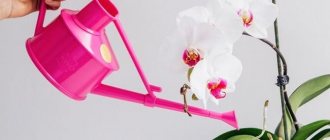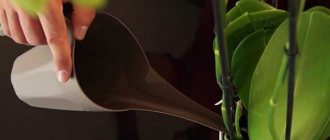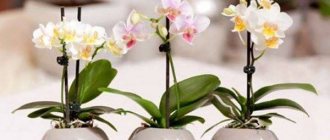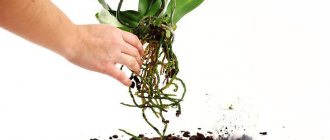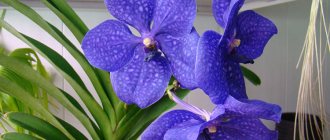World famous for their extraordinary beauty, diversity of species, grace, bordering on bright contrasts of colors, orchids, however, are very demanding to care for. This applies to location, lighting, feeding, humidity and temperature conditions.
But one of the most important foundations supporting the unique fragility and genius of the orchid species is watering.
In this article we will look at how to properly water an orchid at home.
Soil and pot at home
The royal orchid attracts with its beauty and grandeur. At the same time, it is not easy to provide the plant with comfortable conditions in which it will bloom like in the wild. In nature, the flower is accustomed to growing on trees and receiving nutrition through aerial roots.
Breeding orchids at home became possible after the development of less demanding hybrids, but they also require a special moisture-intensive substrate. You can prepare the soil yourself using tree bark, expanded clay, sphagnum moss, coal and other components.
The soil for the flower must meet three main criteria:
- have the ability to retain water for the root system;
- keep moisture in the pot for no more than four days;
- be loose and allow air to pass through well.
The root system must be in a clay or plastic pot, which must meet the following requirements:
- the volume of the pot corresponds to the size of the roots;
- the lower side of the pot has many drainage holes;
- transparent material (for epiphytic plants).
Read more about how to choose a flower pot here.
Choice of water
Watering an orchid with tap water is highly undesirable. Such water is hard, chlorinated and contains pipeline deposits, which does not correspond to the natural irrigation the plant is accustomed to.
Tropical rains are clean and soft. Watering can be brought into line with the natural environment through disinfection and softening. This result will be achieved by:
- boiling;
- settling;
- filtration;
- acidification of liquid;
- freezing;
- rainwater collection.
The water temperature should be 30-35 degrees.
How to spray correctly?
Spraying should be fine. The procedure is carried out from a distance of at least 20 cm so that large drops of water do not fall on the leaves.
Water for spraying must meet all the orchid’s liquid requirements, that is, be warm, settled and soft.
It is forbidden to spray those plants that have been in the sun for a long time. The procedure is not carried out in winter.
How to correctly understand that it is time?
Each plant differs in the frequency and intensity of watering. The orchid prefers to be in semi-dry soil rather than grow from a well-moistened substrate. It is not easy to maintain a fine line, not to dry out or over-moisten the soil.
Between procedures, the substrate should dry well. Several signs will help identify the need for moisture:
- “light” pot;
- absence of drops on substrate particles and plant roots;
- light gray color of the roots (green roots indicate good moisture).
Determining the need for watering
There is no specific schedule for watering plants of the orchid family. The regularity of moisturizing depends on many factors: the variety of orchid, the type of pot and substrate, the flowering period, and environmental conditions.
The key rule when watering is to moisten the substrate abundantly, but not often. Excess moisture is more dangerous for most varieties of orchids than deficiency, so the root system and soil must be completely dry before the next watering.
You can determine that a plant requires watering by the following signs:
- there are no droplets of condensation on the walls of the transparent flowerpot;
- the roots have lost their rich green color and acquired a grayish tint;
- the weight of the pot when lifted is significantly less than after watering;
- support stick, pulled out from the substrate, dry along its entire length.
Features and mode
The plant is not moisture-loving. Roots are much more comfortable in loose and dry soil. On average, the intensity of watering is in the range of 7-14 days. It is worth considering that in winter the plant drinks a little less. The frequency of irrigation is affected not only by the time of year, but also by certain phases of flower development.
Depending on the growth phase
A young plant that is just beginning to form leaves and is actively growing requires regular moisture. During this period, the soil should not be allowed to dry out and moderate watering should be done at least once a week.
It is recommended to control the humidity in the room. In a moist environment, the flower will grow quickly, form strong roots and a leaf system.
At different times of the year (spring, summer and winter)
The climatic conditions of summer and spring imply low air humidity, plenty of sunlight and long daylight hours. At this time, the orchid requires frequent and abundant moisture.
In winter, the frequency should be reduced. The room where the plant is located should be cool and the air humidity level should be above 60%.
Regardless of the time of year, caring for a flower involves wiping the leaves of the plant at least twice a month. The procedure will remove dust and pathogenic bacteria from the leaves.
During flowering
The orchid begins to shoot arrows to bloom only in dry soil. Therefore, before the flowering phase, it is necessary to reduce watering in order to create comfortable conditions for the roots.
The formation of buds takes a lot of energy from the plant, so during this period it is necessary to provide the flower with abundant moisture.
The beginning of flowering also requires good moisture. It is necessary to water the orchid in a timely manner and abundantly. It is necessary to monitor the condition of the soil and prevent compaction, leaving it light and well ventilated.
During the active flowering phase, the crop should be watered at least once every two weeks, allowing the substrate to dry thoroughly between procedures. It is important that moisture does not stagnate in the soil, this can lead to rotting of the root system and dropping of flowers.
Determine when is better: morning or evening?
Morning time is considered the most favorable period for hydration. It is better to saturate the root system with water enriched with oxygen in the morning, so that excess moisture has time to evaporate before nightfall.
Tips for orchid lovers
- Be sure to familiarize yourself with the care features of the type of orchid you are going to grow;
- If you have several orchids, try to water them one by one . This way you can prevent the transfer of bacteria from one flower to another;
- Pay attention to seasonal and cyclical changes in the life of your orchids to know how best to provide them with the right regime for regular flowering and active growth.
Methods: description and photo
Orchids, unlike other plants, allow several methods of watering. The choice and application of one method or another depends on the needs of the flower.
In a pallet
The method is suitable for pots with a tray, for example, the “Crown” system. The prepared water is poured into the pan to the top level, after which the plant will independently absorb the required amount of moisture. The method is used for the growth phase when the plant does not require abundant moisture.
From above from a watering can
The traditional method is a thin stream through the top of the pot.
Water pours out of the watering can slowly and is completely distributed throughout the substrate.
You need to continue this type of watering until excess moisture begins to pour out of the drainage holes into the pan. After 2-3 minutes, it is necessary to repeat the spilling of the root system, and then remove excess liquid from the pan.
Soaking and immersion method
The immersion method involves placing the pot in a large tray with prepared water. This method allows you to evenly saturate the substrate and avoid overflow. To do this, the orchid in the pot is placed in a container of larger diameter, the walls of which are slightly higher than the edge of the pot. Stems and leaves should not come into contact with water.
It is necessary to keep the flower in water for at least 15-20 minutes in the summer and 5-10 minutes in the winter.
From the shower
The plant is shed through the shower head with a medium-strength stream of water, the temperature of which is in the range of 40-50 degrees. After such watering, it is necessary to leave the flower to “rest” for 10-15 minutes to remove excess moisture from the substrate. After the procedure, it is necessary to remove moisture from the leaves and axils of the orchid.
How to make the wick method step by step
The wick method is attractive because the root system has the ability to take as much moisture as it needs in a given period of time.
You need to make a hole in the bottom of the pot through which you pass a synthetic thread through the substrate and lower the end into a pan of water. The required soil moisture will be maintained by the flower itself.
“Wet heels” for a double pot
The heel method involves using a double pot to contain the orchid. The bottom of the inner container is equipped with small protrusions - “heels” measuring approximately 1-1.5 cm, on which the pot rests. Next, the main container is placed in a slightly larger pot, and water is poured into the free space. The root system will be moistened through functional holes at the bottom.
Oversaturation of the substrate with water is completely excluded.
Choosing a system for indoor views
Some varieties have specific moisture requirements.
- Dendrobium - requires plenty of moisture in spring and summer. The most effective method is immersion in room water for 5-10 minutes.
- Lady's slipper (paphiopedilum) - is not capable of retaining water, therefore it requires constant moistening and maintaining moisture in the substrate.
- Cymbidium - use the immersion method for 40 minutes or watering with a watering can for 10-15 minutes.
- Cambria - spraying is not used for these flowers. It is necessary to allow the soil to dry completely.
- Vanda - watering is done only after the soil dries. A hot shower with a temperature of 35-40 degrees is effective.
Read about what irrigation methods to use for phalaenopsis orchids in this article.
When should you spray?
At least once every 2 weeks, it is necessary to spray the stems and leaves to remove dust and pathogenic bacteria.
If the orchid does not grow in a pot, but by free spreading of the root system, root irrigation is used. To do this, irrigate with a spray bottle until the roots turn green.
What you need to know about special cases
Some periods of plant development or growing methods require special watering.
First time after purchase
The first watering of the plant is carried out at least 1 week after purchase. During this time, the plant adapts to the new environment and will survive the shock of the move. Do not apply excessive moisture.
It is recommended to use a gentle tray method so that the roots of the flower independently absorb the required amount of moisture.
2 weeks after purchase, the crop can be transplanted to the main place.
In expanded clay or foam
Keeping an orchid in expanded clay or polystyrene foam does not require special watering skills. An indicator of drying will be the roots of the plant, which will take on a silvery appearance.
It is recommended to use a gentle method of moisturizing - using a tray. Moisture will penetrate through the functional hole, and expanded clay or foam will independently and evenly distribute water over the entire area of the root system.
Plant planted in sphagnum moss
Growing an orchid in moss creates conditions as close as possible to the natural environment. This is due to the ability of sphagnum to retain moisture for a long time and distribute it evenly throughout the root system of the plant.
The orchid does not require frequent watering in such conditions. It is better to moisturize once every two weeks by irrigation.
In a closed system in a pot without holes
Soil in a pot without functional holes retains moisture much longer. Frequent irrigation with such maintenance will lead to stagnation of liquid and rotting of the roots.
An orchid in such a pot should be watered no more than once every 2 weeks.
Water is poured into the container to the level of root growth. After 30-45 minutes, the liquid is drained by carefully tilting the vessel.
After transplantation into dry bark
The rules for moisturizing after transplanting into dry bark depend on the time of year. In summer, moistening of the substrate after transplantation must be done after 24 hours, and in winter after 2-3 days.
In a flowerpot
He considers watering in pots to be the safest way, which will not lead to excessive moisture and drought. It is enough to pour 1-2 cm of water into the bottom of the pot and immerse the flowerpot in it. The roots will be saturated with the required amount of water on their own.
Answers to frequently asked questions
Which watering method is best to choose?
You need to focus on the type of orchid. In general, it is better to alternate all methods. This way you will recreate the natural growing conditions of this plant as accurately as possible.
What kind of water does an orchid like?
Warm, not hard, settled. Experienced florists boil the liquid to kill all germs. The ideal option is to collect rainwater. But not everyone can afford it. So settle the irrigation liquid and warm it before the procedure.
How to accurately understand that a flower needs to be watered?
It is best to grow an orchid in a clear plastic pot. Then the need for irrigation can be determined visually. Otherwise, use a sharp stick to pierce the substrate. If the stick is wet, there is no need to water it.
